-
Back
Home
BGP
-
- Introduction
The Border Gateway Protocol (BGP) is an
interautonomous system routing
protocol. An
autonomous
system is a network or group of networks under a common administration and
with common routing
policies.
BGP is used to exchange routing
information for the Internet and is the protocol used between
Internet service providers (ISP).
-
- Customer networks, such as
universities and corporations, usually employ an Interior Gateway Protocol
- (IGP) such as RIP or OSPF
for the exchange of routing information within their networks.
-
- Customers connect to ISPs,
and ISPs use BGP to exchange customer and ISP routes. When BGP is used
- between autonomous systems
(AS), the protocol is referred to as External BGP (EBGP). If a service
provider
- is using BGP to exchange
routes within an AS, then the protocol is referred to as Interior BGP (IBGP).
-
- Figure illustrates this
distinction

- BGP is a very robust and
scalable routing protocol, as evidenced by the fact that BGP is the routing
protocol employed on the Internet. At the time of this writing, the Internet
BGP routing tables number
more than 90,000 routes. To achieve scalability at this level, BGP uses many
route parameters, called
attributes, to define routing policies and maintain a stable routing
environment.
In addition to BGP attributes, classless interdomain routing (CIDR) is used by
BGP to reduce the size
of the Internet routing tables. For example, assume that an ISP owns the IP
address block 195.10.x.x
from the traditional Class C address space. This block consists of 256 Class C
address blocks, 195.10.0.x
through 195.10.255.x. -
- Assume that the ISP assigns
a Class C block to each of its customers. Without CIDR, the ISP would
advertise
- 256 Class C address blocks
to its BGP peers. With CIDR, BGP can supernet the address space and advertise
- one block, 195.10.x.x. This
block is the same size as a traditional Class B address block. The class
distinctions
- are rendered obsolete by
CIDR, allowing a significant reduction in the BGP routing tables.
BGP neighbors exchange full routing information when the TCP connection
between neighbors is first
established. When changes to the routing table are detected, the BGP routers
send to their neighbors only
those routes that have changed. BGP routers do not send periodic routing
updates, and BGP routing
updates advertise only the optimal path to a destination network.-
- BGP Attributes
Routes learned via BGP have associated properties that are used to determine
the best route to a
destination when multiple paths exist to a particular destination. These
properties are referred to as BGP
attributes, and an understanding of how BGP attributes influence route
selection is required for the
design of robust networks. This section describes the attributes that BGP uses
in the route selection
process:
. Weight
. Local preference
. Multi-exit discriminator
. Origin
. AS_path
. Next hop
. Community
Weight Attribute
Weight is a Cisco-defined attribute that is local to a router. The weight
attribute is not advertised to
neighboring routers. If the router learns about more than one route to the
same destination, the route with
the highest weight will be preferred. -
- In Figure Router A is
receiving an advertisement for network 172.16.1.0 from routers B and C. When
Router
- A receives the advertisement
from Router B, the associated weight is set to 50. When Router A receives the
- advertisement from Router C,
the associated weight is set to 100. Both paths for network 172.16.1.0 will be
in
- the BGP routing table, with
their respective weights. The route with the highest weight will be installed
in the
- IP routing table.
Figure BGP Weight
Attribute
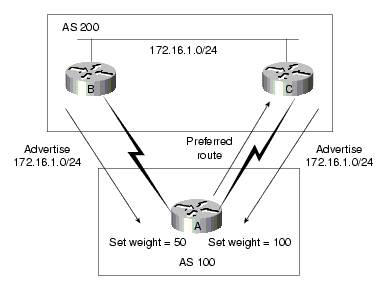
- Local Preference
Attribute
The local preference attribute is used to prefer an exit point from the local
autonomous system (AS).
Unlike the weight attribute, the local preference attribute is propagated
throughout the local AS. If there
are multiple exit points from the AS, the local preference attribute is used
to select the exit point for a
specific route. -
- In Figure AS 100 is
receiving two advertisements for network 172.16.1.0 from AS 200. When Router A
- receives the advertisement
for network 172.16.1.0, the corresponding local preference is set to 50.
- When Router B receives the
advertisement for network 172.16.1.0, the corresponding local preference
- is set to 100.
-
- These local preference
values will be exchanged between routers A and B. Because Router B has a
higher
- local preference than Router
A, Router B will be used as the exit point from AS 100 to reach network
- 172.16.1.0 in AS 200.
-
- BGP Local Preference
Attribute
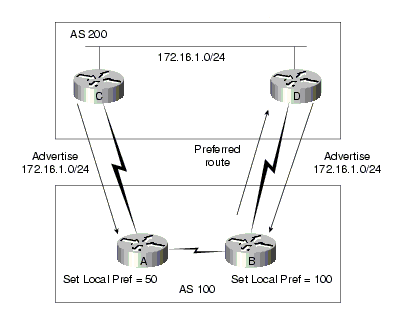
- Multi-Exit Discriminator
Attribute
The multi-exit discriminator (MED) or metric attribute is used as a suggestion
to an external AS
regarding the preferred route into the AS that is advertising the metric.
The term suggestion is used because the external AS that is receiving the MEDs
may be using other BGP
attributes for route selection. We will cover the rules regarding route
selection in the next section. In
Figure Router C is advertising the route 172.16.1.0 with a metric of 10, while
Route D is
advertising 172.16.1.0 with a metric of 5. The lower value of the metric is
preferred, so AS 100 will
select the route to router D for network 172.16.1.0 in AS 200. MEDs are
advertised throughout the local
AS.
Origin Attribute
The origin attribute indicates how BGP learned about a particular route. The
origin attribute can have
one of three possible values:
IGPThe
route is interior to the originating AS. This value is set when the network
router
configuration command is used to inject the route into BGP.
EGPThe
route is learned via the Exterior Border Gateway Protocol (EBGP).
IncompleteThe
origin of the route is unknown or learned in some other way. An origin of
incomplete occurs when a route is redistributed into BGP.-
- BGP Multi-Exit Discriminator
Attribute
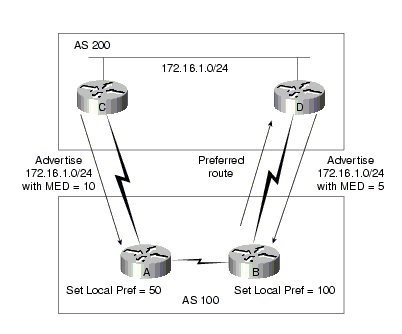
- AS_path Attribute
When a route advertisement passes through an autonomous system, the AS number
is added to an
ordered list of AS numbers that the route advertisement has traversed. Figure
shows the situation
in which a route is passing through three autonomous systems.
AS1 originates the route to 172.16.1.0 and advertises this route to AS 2 and
AS 3, with the AS_path
attribute equal to {1}. AS 3 will advertise back to AS 1 with AS-path
attribute {3,1}, and AS 2 will
advertise back to AS 1 with AS-path attribute {2,1}. AS 1 will reject these
routes when its own AS
number is detected in the route advertisement. This is the mechanism that BGP
uses to detect routing
loops. AS 2 and AS 3 propagate the route to each other with their AS numbers
added to the AS_path
attribute. These routes will not be installed in the IP routing table because
AS 2 and AS 3 are learning a
route to 172.16.1.0 from AS 1 with a shorter AS_path list.
BGP AS-path Attribute
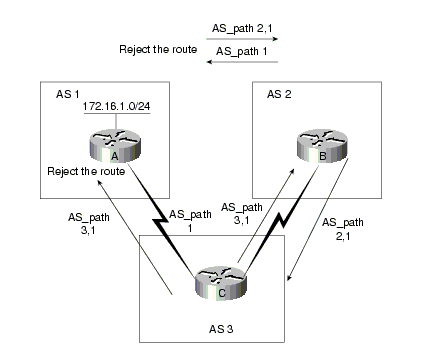
Next-Hop Attribute
The EBGP next-hop attribute is the IP address that is used to reach the
advertising router. For EBGP
peers, the next-hop address is the IP address of the connection between the
peers. For IBGP, the EBGP
next-hop address is carried into the local AS, as illustrated in Figure
BGP Next-Hop
Attribute
-

-
- Router C advertises network
172.16.1.0 with a next hop of 10.1.1.1. When Router A propagates this
route within its own AS, the EBGP next-hop information is preserved. If Router
B does not have routing
information regarding the next hop, the route will be discarded. Therefore, it
is important to have an IGP
running in the AS to propagate next-hop routing information.
-
- Community Attribute
The community attribute provides a way of grouping destinations, called
communities, to which routing
decisions (such as acceptance, preference, and redistribution) can be applied.
Route maps are used to set
the community attribute. Predefined community attributes are listed here:
. no-export
Do not advertise this route to
EBGP peers.
. no-advertise
Do not advertise this route to
any peer.
. internet
Advertise this route to the
Internet community; all routers in the network belong to it.
Figure illustrates the no-export community. AS 1 advertises 172.16.1.0 to AS 2
with the community
attribute no-export. AS 2 will propagate the route throughout AS 2 but will
not send this route to AS 3
or any other external AS.
BGP no-export Community
Attribute
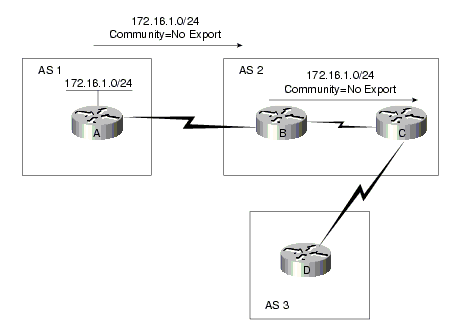
AS 1 advertises
172.16.1.0 to AS 2 with the community attribute no-advertise. Router B
in AS 2 will not advertise this route to any other router.
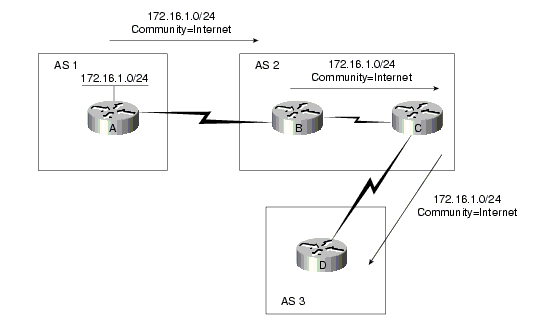
-
- BGP Path Selection
BGP could possibly receive multiple advertisements for the same route from
multiple sources. BGP
selects only one path as the best path. When the path is selected, BGP puts
the selected path in the IP
routing table and propagates the path to its neighbors. BGP uses the following
criteria, in the order
presented, to select a path for a destination:
. If the path specifies a next hop that is inaccessible, drop the update.
. Prefer the path with the largest weight.
. If the weights are the same, prefer the path with the largest local
preference.
. If the local preferences are the same, prefer the path that was originated
by BGP running on this
router.
. If no route was originated, prefer the route that has the shortest AS_path.
. If all paths have the same AS_path length, prefer the path with the lowest
origin type (where IGP is
lower than EGP, and EGP is lower than incomplete).
. If the origin codes are the same, prefer the path with the lowest MED
attribute.
. If the paths have the same MED, prefer the external path over the internal
path.
. If the paths are still the same, prefer the path through the closest IGP
neighbor.
. Prefer the path with the lowest IP address, as specified by the BGP router
ID.
Back
Home








